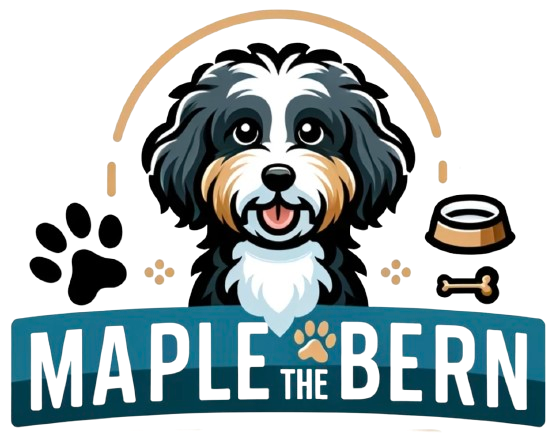
Note: This article’s statistics come from third-party sources and do not represent the opinions of this website.
Over the past few years, mounting concern over the environmental impact of meat consumption has led to plant-based alternatives to meat and poultry being introduced to shops and restaurant chains all over the UK.
But it’s not just the environment that consumers are worried about—people are interested in knowing exactly where their food comes from, how it’s been grown, and in the case of meat, the conditions in which the animals were raised.
Factory farming is often seen as an overseas venture. It’s most commonly associated with the giant US mega-farms seen in various popular TV documentaries. The truth is, data suggests that there are more than 1,000 factory farms in the UK—and that number doesn’t even include farms in Scotland.
Interested in seeing more statistics about factory farming in the UK? Keep reading.
Click below to jump ahead:

Top 10 Disheartening UK Factory Farming Statistics
- Of all farmed animals in the UK, 73% are kept in factory farms.
- Of all chickens raised in the UK, 95% are factory farmed.
- Chickens in factory farms have floorspace that is equivalent to an A4 piece of paper.
- In the summer of 2022, millions of chickens died in sheds as temperatures soared.
- The largest chicken factory can hold up to 1.7 million birds.
- The biggest pig factory can hold 23,000 pigs.
- Each pig is entitled to approximately one square metre of space.
- Around 60% of sows give birth within the confines of a farrowing crate.
- The largest dairy mega farm in the UK holds 2,000 animals.
- The largest cattle mega farm can hold a herd of around 3,000 cattle.

General Statistics
1. Of all farmed animals in the UK, 73% are kept in factory farms.
(The Guardian)
Figures conducted by an investigation in 2021 reported that the UK had 1,099 US-style mega-farms. Due to a cyber-attack, this figure did not include the number of factory farms in Scotland—the number of factory farms scattered throughout the UK today is likely to be higher.
The result is that at least 73% of the UK’s farm animals are grown in the confines of factory farms. Some of these farms hold more than a million animals at a time.
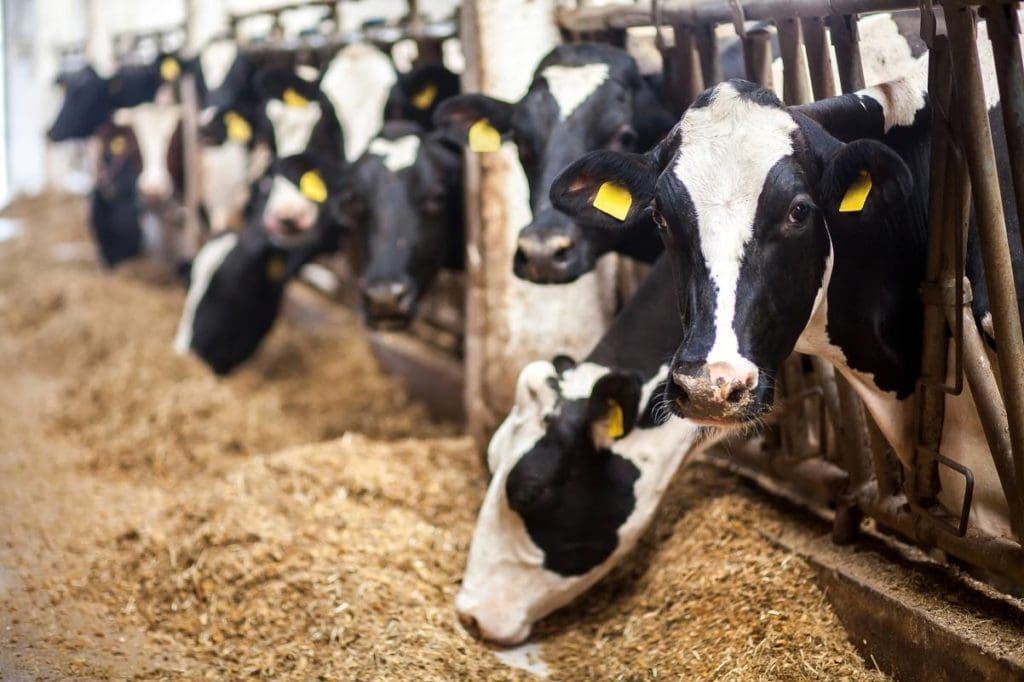

Chicken Mega Farms
2. Of all chickens farmed in the UK, 95% are factory farmed.
(Independent)
The UK population consumes a staggering amount of chicken. According to statistics from the government, around 90 million broilers—meat chickens—are slaughtered each month.
A staggering number of hens are also needed to provide the 11.3 billion eggs produced in the UK each year.
To keep up with demand and keep prices low, around 95% of chickens in the UK are raised in factory farms.
3. Chickens in factory farms have floor space that is equivalent to an A4 sheet of paper.
(RSPCA)
Enriched battery cages are used worldwide to maximize egg production. Approximately 48% of eggs produced in the UK come from battery cages.
Regulations state that battery cage chickens must each have 600 cm squared of usable floorspace—less than the size of an A4 sheet of paper.
Each enriched battery wire cage typically holds around 80 hens, and they are usually stacked in tiers.
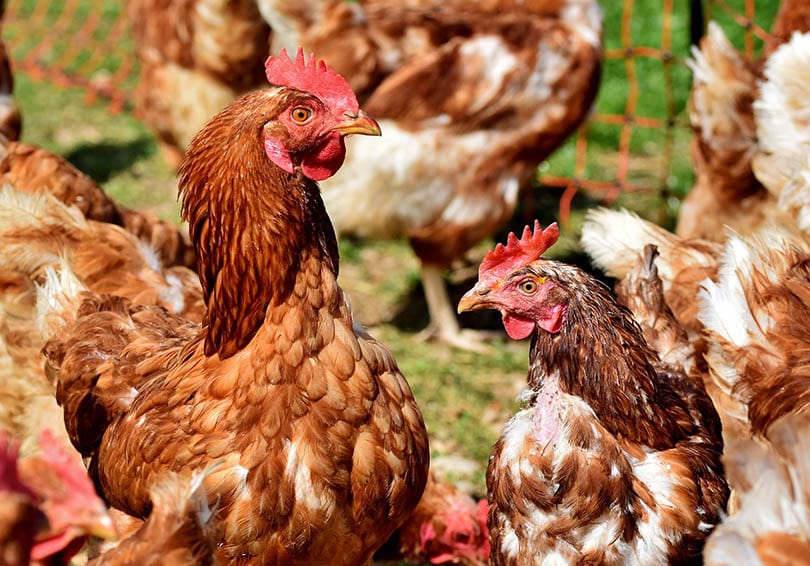
4. In the summer of 2022, millions of factory chickens died due to heat exhaustion.
(Independent)
As temperatures soared throughout the UK in the summer of 2022, whistleblowers from mega-farms reported that millions of chickens had died as a result of heat exhaustion.
During the heatwave, temperatures within chicken sheds reached 45°C. Witnesses reported that the birds suffered from diarrhea as a result of heat exhaustion, and the higher amount of bird excrement worsened the temperature conditions.
Witnesses claimed that the chickens were “left to die in the heat,” and written off as a cost.
5. The largest chicken factory can hold up to 1.7 million birds.
(The Bureau of Investigative Journalism)
Any farm that has the capacity to house at least 40,000 poultry birds is classified as an intensive farm by the Environment Agency. The two largest chicken farms in the UK are able to hold 1.7 million and 1.4 million birds, respectively.
Penrhos chicken farm in Herefordshire houses just under 170,000 chickens.
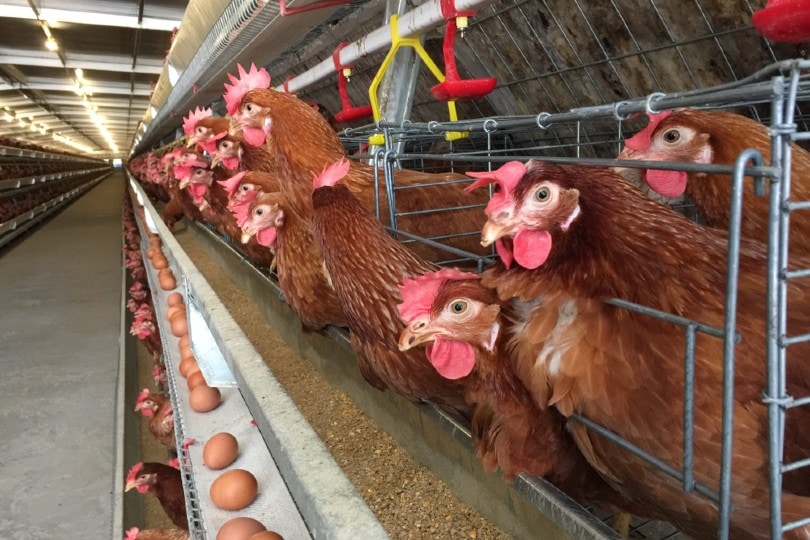

Pig Factories
6. The biggest pig factory can hold 23,000 pigs.
(The Bureau of Investigative Journalism) (BBC)
The Environment Agency classifies farms that have the capacity to house 2,000 pigs as “intensive”.
With a capacity of 23,000 pigs, the biggest pig farm in the UK can facilitate more than ten times that amount.
In late 2022, one of the UK’s largest pig factory farms—Flat House Farm in Leicestershire—was shut down following serious allegations of animal welfare breaches. The company admitted that the farm did not have enough enrichment activities for its 9,000 pigs.
7. Factory farm pigs are each entitled to approximately one square meter of space.
(DEFRA) (Animal Equality)
According to UK guidelines, each gilt must be provided with 0.95 square meters of a continuous solid floor.
In the UK, 71% of pigs’ tails are docked when they are just 1–3 days old. The procedure, which is usually carried out without the use of anesthetics, is done to stop tail-biting—a phenomenon that’s typically motivated by stressful situations, such as a lack of space, boredom, frustration, and lack of enrichment.
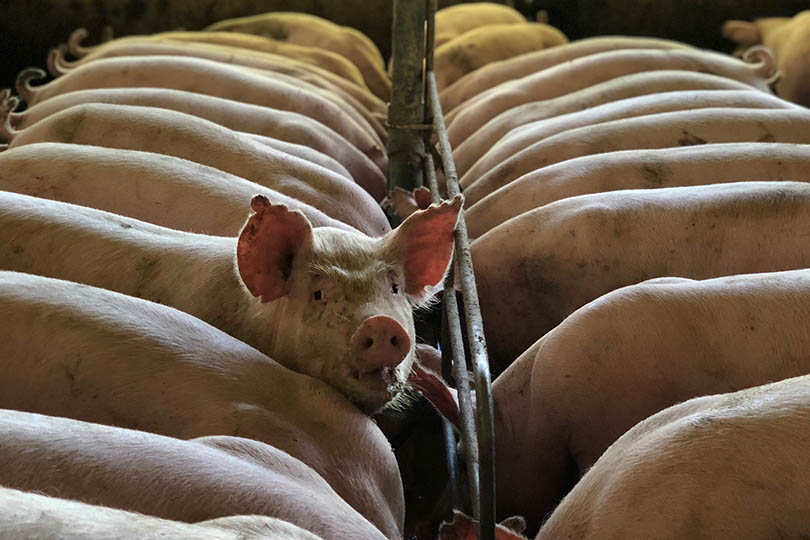
8. Around 60% of sows give birth within the confines of a farrowing crate.
(RSPCA Assured)
Farrowing crates are barred metal crates where pregnant sows are confined just before they give birth, up until their piglets are around 28 days old. They prevent the sow from turning around, allowing them only to move forward and backwards a little bit. Farrowing crates can cause these sows a significant amount of stress.
Despite this, 60% of sows in the UK give birth while they are confined in a farrowing crate.

Dairy and Cattle Farms
9. The largest dairy mega farm in the UK holds 2,000 animals.
(The Guardian)
Philip Lymbery, the chief executive of Compassion in World Farming, revealed in a book that there are at least 19 mega-dairies across the UK. The largest farm appears to hold 2,000 animals.
Cows which are housed in such “intensive” dairies are “zero-graze”—in other words, they are not permitted to go out onto fields. Instead, these cows are permanently kept inside sheds.
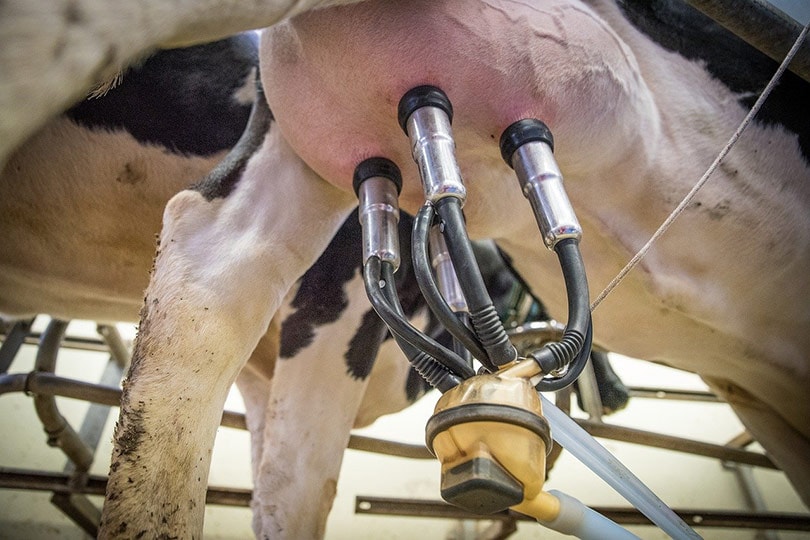
10. The largest beef mega-farm can hold a herd of around 3,000 cattle.
(The Guardian)
Herds of up to 3,000 cattle are being housed in grassless pens for long periods. Unlike intensive pig and poultry farms, beef factory farms do not need a government permit in order to operate.
According to one report, cattle are allowed to graze on fields prior to being confined in a pen for fattening. Most cattle will spend around a quarter of their lives in cramped, confined grassless pens.

Frequently Asked Questions About Factory Farming in the UK
What is factory farming?
Factory farming is a system of intensive farming, or farming in a concentrated amount, designed to maximize production and profits using the least amount of resources possible.
Typically, large numbers of livestock are kept in small spaces, most often for the duration of their lives.
Critics are concerned that animals grown in factory farms are subject to cruelty, while environmental activists worry that these mega-farms have a detrimental effect on pollution, global warming, deforestation, the overuse of water, and biodiversity loss.
How much of UK farming is factory?
According to a study conducted by Compassion in World Farming, 73% of farmed animals in the UK are raised in factory farms.
CiWF explains that at least 40,000 dairy cows, 11 million laying hens, 100 million broiler chickens, and 1.3 million pigs are kept in intensive farming conditions in the UK.
(CiWF)
Are cows factory farmed in the UK?
There are at least 19 mega-dairies in the UK, of which the largest holds around 2,000 cows. Most mega-dairies do not allow the cows to graze on a field.
There are also several beef factory farms. These farms often place up to 2,000 cattle in a cramped, grassless fattening pen.
Unfortunately, it’s difficult to find statistics on the real number of cows kept in factory farms in the UK, because such farms are not required to gain a permit from the government, and there are no official records on how many are in operation. (TBIJ)
Are animals in factory farms happy?
Many organizations around the world are concerned about the welfare of animals in factory farms. Aside from crowded and confined settings that can lead to stress, boredom, and frustration, animals are often subject to practices that are designed to make them fit the farming process.
For example, the separation of day-old calves from their mothers often results in the mother suffering from anxiety, male piglets are often castrated without anesthetics, many pigs are routinely tail-docked, and chickens have their beaks trimmed. (The Humane League UK)
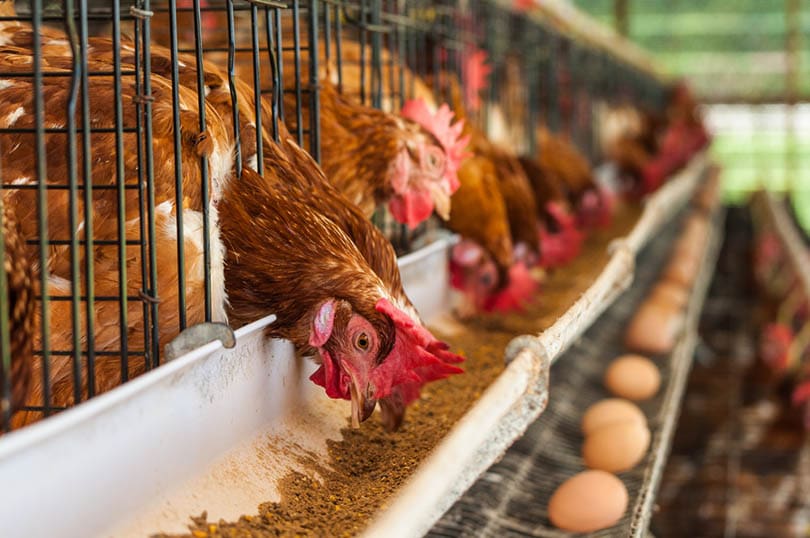
Are farrowing crates good for pigs?
While it may appear that farrowing crates are good because they prevent the piglets from getting crushed, they physically restrict the sows, causing them stress and discomfort.
There is evidence to suggest that the stress caused by farrowing crates is associated with an increased number of stillbirths and negative maternal behaviors. (RSPCA Knowledgebase)
What are the alternatives to factory farming?
One alternative to factory farming is sustainable livestock farming. Animals on such farms are usually pasture-raised, and provided with as much of their natural habitat and natural diet as possible.
Sustainably and ethically farmed foods usually come at a higher price to the end consumer, but in return, it is better for the environment, the animals, and also for the consumer’s health.
Another alternative is to produce more meat-free foods, or “clean-meats”—cell-grown meat that is produced in a lab. As consumers move towards meat-free alternatives, the demand for mega-farms will dampen, and theoretically, production should decline.
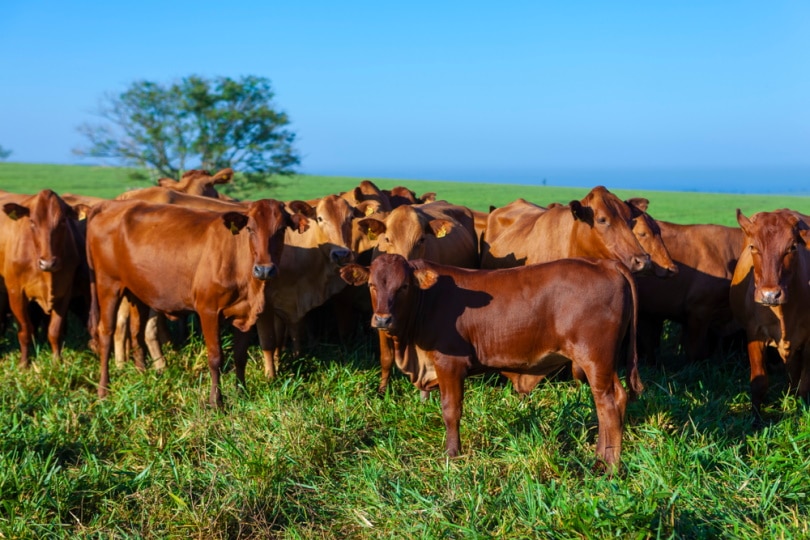

Conclusion
Most of the meat and dairy products lining the shelves of our local supermarkets come from factory farms. In addition, it’s not just the fresh meat and dairy you buy that come from intensive farms, but also the ingredients used in many ready-baked and frozen products.
As disheartening as these statistics are, the UK population is becoming more aware of the negative impacts of factory farming every day. Consumers can look out for “free range” stamps on egg boxes and RSPCA Assured labeling on meat products when out shopping.
Featured Image Credit: matthiasboeckel, Pixabay
